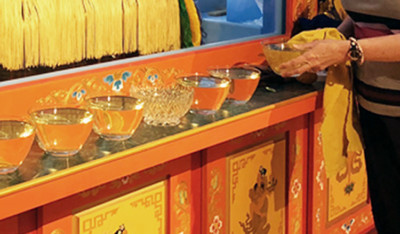
Andrew Hughes is a first year Year Master of Divinity Student at Maitripa College
“Coming In Out of the Woods” by Andrew Hughes
Five years ago while I living in Austin, Texas, well before I had any idea that I might attend school at Maitripa College, my partner and I went to a Buddhist center for a meditation session. The center was relatively small, with room for about 20 people. Immediately upon entering, the meditation hall felt foreign. The various altars, the images of the gurus, the bright golds, yellows and reds of the decorative cloths—I did not know what to make of it; the culturally foreign aspects of the experience felt distracting and unnecessary.
My partner, myself, and the man who led us, were the only people there. Having had a personal practice for some years, I was comfortable sitting (or so I thought!). But when the man leading the session began to chant in Tibetan, I became uncomfortable. I’d never been exposed to chanting before, in any language, and rituals like this were unfamiliar to me. The man spoke rapidly with a flat, expressionless intonation, his voice dropping in tone. I tried to follow along in the prayer book he’d given us. I had no idea what I was doing or why and I just wanted it to be over so I could get back to sitting. All I could think about was how artificial it felt to me. What was the point of chanting? I had no understanding of the value of lineage, ritual, and tradition on the spiritual path.
But you never know where life will take you, what changes it will bring. My senior year in college I had my entire life planned. “Success” was guaranteed. I was engaged to be married and accepted into an MD / PhD program at a prestigious medical school. Two years later, no longer engaged and no longer going to medical school, I found myself in a large tent at Forward Operating Base Anaconda near Balad, Iraq, about 100 miles north of Baghdad, deejaying a techno party for soldiers who danced energetically waving glow sticks while the M16s strapped to their backs bounced to the rhythm of the music.
That is to say, I know curveballs. I love them. They keep me from taking myself or any moment of life too seriously. They remind me not to judge too quickly.
This open mind was helpful when I visited Maitripa College, while I was still trying to decide if I was going to attend. At the time, I was still uncomfortable with many of the traditional Tibetan aspects of the school and the lineage. I used to like to say that I’m not a “joiner.” I wanted to be open, but I had no context. Despite feeling the truth of so many of the teachings I’d listened to or read, I was reluctant to call myself “Buddhist.”
During that visit, I attended a meditation class with Yangsi Ripoche. Before class, we stood in the meditation hall and waited for him to enter. I bowed my head slightly and felt awkward. The other students did the same. I knew class began with the practice of prostrations. One of the faculty members had introduced me to the concept and had demonstrated the practice.
I had not bowed to anything in my life, much less prostrated, and as an American male, I had spent most of my life taking in the message that such subjugation was unmanly or weak. Even if I did not subscribe to such typical gender ideas, the message was still in there. Who was I bowing to? These golden statues? Why? What was the point?
Soon Rinpoche entered. He walked in with his head bowed, body slightly forward, carrying a small bag. On his way to the front of the room, he paused and turned toward me. Perhaps he sensed my doubt and hesitation, but he said, “And now we do Buddhist calisthenics.” He smiled and chuckled a little. It was a beautiful entry into prostrations. It gave me a way to begin to understand the practice.
Over the past two semesters as a student in the program at Maitripa College, I have begun to greatly value the practice of prostrations, and Buddhist rituals in general. Throughout my life I’ve have had so few opportunities to express humility and to surrender, especially after having left my cultural faith tradition. I’ve held so tightly onto myself and my story. I’d never noticed the burden of carrying the ongoing narrative about who I was, who I was supposed to be, and all the various regrets and expectations that come along with it. This is such a heavy load to carry.
The first time I truly connected my practice with selflessness, I was sitting in my room in Alaska. I was sitting on my cushion, trying earnestly to meditate, wanting something but not even sure what, working at it. Suddenly, I realized that I did not have to practice for myself alone. I realized that I did not have to live for myself alone. I saw how much work I was putting into generating and maintaining my story. How much time and energy this took. In that moment, I realized the enormous burden that I’d carried, the project of myself—so much worry and busyness and need. For a moment, in that session, I shed it. I let it go in a new way. I felt physically lighter. Of course, like waking from a dream, or like oil seeping into cloth (to borrow a phrase from Practicing the Path), the burden returned. I try to remember to put the burden I carry back down when I can. Prostrations, I discovered, can help with this.
One of our teachings speaks of prostrations as “throwing ourselves fully into the direction” of the path. I understand now that the act of prostration is not self-denigrating; it is not about subjugation. Instead, I feel a sense of surrender to the teachings and to the path. I understand prostrations as small steps in the path to the freedom of letting go. When I prostrate, I imagine my teachers, my partner, my parents, my sangha, and the Buddhas before me. I offer my practice to them in love and respect. I offer my effort to them in love and respect. I let go of some of the projects of self that I get so wrapped up in. I remember that I do not have to carry that burden anymore. I remember that I can instead work joyously for the benefit of others.

A Maitripa College Compassion in Action volunteer offering waterbowls in the Jokhang meditation hall.
Another example of my ongoing journey into the practice of ritual involves water bowls. The Meditation Hall, the Jokhang, as it’s named at Maitripa after the famous temple in Lhasa, Tibet, has a number of altars. In front of each altar are seven carefully placed glass bowls. The bowls are filled with water scented with saffron. Emptying, cleaning, and filling the bowls is a daily ritual offering. It was suggested that we should fill the bowls with joy, as if we are pouring tea for our family.
During my first semester, students were offered the opportunity to volunteer for the water bowl offerings. I volunteered. I did this because I did not understand the practice. I was unsure about it. I was unsure how it fit into my path. But I kept an open mind. There was so much about the teachings and the place that I cherished and trusted, I wanted to see what kind of relationship with this practice I could develop. We were instructed to wash our hands, set our intentions, and prostrate three times before starting the ritual.
For a semester, once a week, I emptied the bowls, carried the water out to the trees, cleaned the bowls, and carefully refilled them. I enjoyed being in the space and being of service to the community. I tried not to rush through the practice. I tried not to see it as a “chore.”
Sometimes I succeeded; sometimes, when school or work felt particularly busy, I failed. When I was being particularly “good,” I would pause before each altar and think of some attachment, delusion, or ignorance that I wanted to let go of, and while I emptied the water, I imagined that quality being emptied into the bucket. When I refilled the bowls, I would imagine love and compassion and wisdom filling me in return.
It was not, however, until several weeks ago (well into my second semester at Maitripa) that I made a direct connection between the ritual and my practice. One of my professors had mentioned early on that the water bowl offering ritual could be a deep practice. Yes, yes, I thought at the time, just like anything can be a practice.
I was emptying the old water from the offering bowls into the bucket that we use to carry the water outside to the trees, where we release it. The bucket is a pretty standard white bucket with “Emptying Only” written on the side with a black sharpie. As I was emptying one of the bowls, I noticed the movements of my hand, how sharp and sudden they were. They felt jerky and hurried. I watched the yellow water dump into the water in the bucket. It swirled opaque before settling and clearing.
I connected this with my mind while sitting. When sitting, I struggle with excitement and scattering. My mind often feels like the water. It is pulled in many directions. I chase it around, trying to herd it. I grasp at thoughts and push and pull them quickly, hurriedly.
Suddenly there was no difference between the practice of water bowls and of working with my mind. The water pouring into water became a visual metaphor for working with my mind. I saw that my thoughts reflected my movements and my movements reflected my thoughts. I saw that by being present and gentle and slow while refilling the water bowls, I was training my mind to be gentle, slow and careful too. I began pouring the water gingerly, gently, with love and care. I watched the turbulence settle and fade on its own, without any need from me. Later, when sitting, I thought back to my water bowl practice, and felt the same ease and equanimity while watching my turbulent thoughts slowly settle without attachment or dissatisfaction.
Over this past year at Maitripa College I have learned to greatly appreciate the rich Tibetan tradition that the school is founded upon. Many times studying the philosophy or practices, I have seen lessons that I learned in my own practice echoed back at me, and, wonderfully, I have found them embedded in a 2,500-year-old tradition of brilliant thinkers that have taken the lessons deeper than I could have imagined and have walked the path further than I would have believed possible—and they took notes!
Feeling the truth of these lessons echoed in my own experience has allowed me to stay open to aspects of the path that I did not understand initially (or do not understand). When I chant the Foundation of All Good Qualities in Tibetan—which I do frequently, practicing it in my car or while walking, trying to memorize it in Tibetan—I think of my experience at the Shambala center in Austin, Texas. I think about the man chanting in Tibetan, and how I sat uncomfortably waiting for it to end. I think about how I struggled with a sense of judgement, not understanding why he would express his path in so foreign a manner. Now I more clearly see a man earnestly working on his path, and I appreciate the lesson in not-knowing. I hope the man’s path is full of joy and meaning.
I am grateful now to have had the door opened for me to practices like water bowl offerings, prostrations, and chanting. I am grateful for the rich traditions I benefit from: both the nascent Western lineage and the deeper Tibetan and Indian lineages. I am grateful, also, for the lessons in humility and not-knowing, and for the reminder that I never know where life will take me or what lessons it will teach me. These moments of direct connection are something that I love about the Buddhist path. The practice of ritual as a form of meditation, which was once so uncomfortable, is now helping me develop my mind to work joyously for the benefit of others. This, I believe, is freedom.


